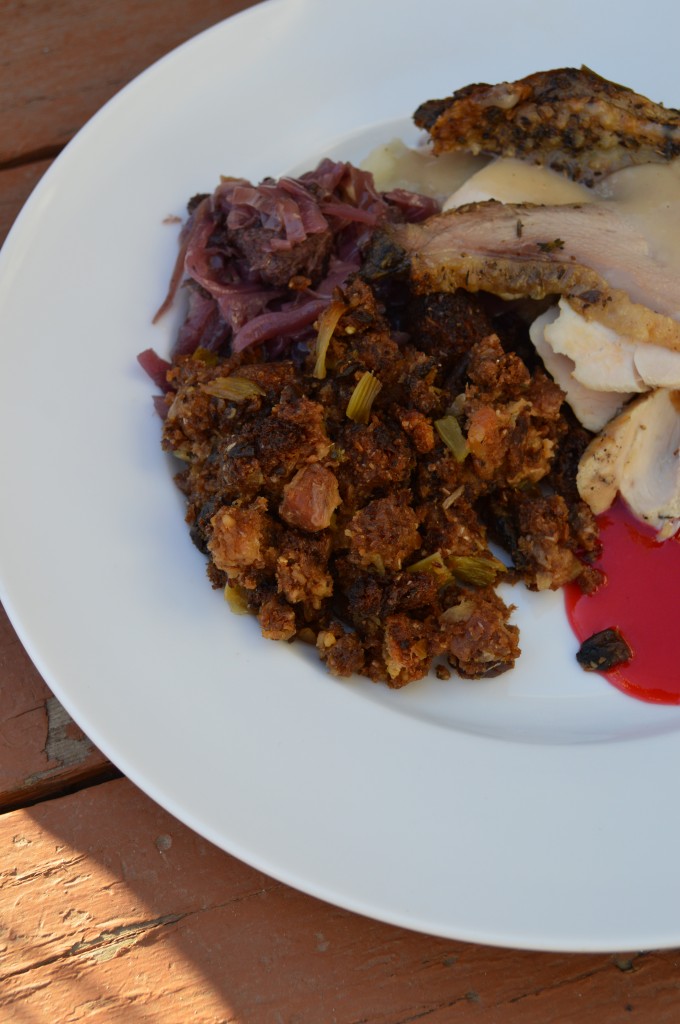 I say this without exaggeration: I hold stuffing as one of the greatest culinary traditions of the New World. I know the British and French and many others make similar dishes, but stuffing, or dressing, is an indispensable dish for the Thanksgiving table. Technically it is an accompaniment to the turkey. I often have to remind myself of this.
I say this without exaggeration: I hold stuffing as one of the greatest culinary traditions of the New World. I know the British and French and many others make similar dishes, but stuffing, or dressing, is an indispensable dish for the Thanksgiving table. Technically it is an accompaniment to the turkey. I often have to remind myself of this.
So. What is stuffing? Stuffing is bread. As the name implies, it was originally crammed into the cavity of poultry, absorbing the juice and fat exuded from the bird during cooking. While this method is still common in Canadian homes, it is giving way to “stuffing” that is prepared in a casserole instead of a bird. There are two reasons for this trend. Most importantly: even a bird as large as a turkey cannot accommodate the volume of stuffing that is required to sate the appetite of the typical North American family. Also, by the time the stuffing cooks through the surrounding meat is overcooked and dry.
Making stuffing in a casserole solves these problems, but the cook needs to find a way to get turkey flavour into the dish, which is why I cut up my raw bird and make stock from the carcass a day or two before Thanksgiving.
Flavour. Essential flavours: poultry stock or jus, onion, celery, and herbs, especially sage, thyme, rosemary, and savoury. I recommend deeply toasting the bread before moistening it with the poultry essence.
Texture. Though stuffing is made in almost every home in North America, in my experience no two stuffings are the same. There is in fact a broad stuffing continuum. On one end are the highly bound stuffings which have a relatively high moisture content, and have been worked so that the bread becomes a cohesive paste. This form of stuffing resembles an Austrian Knödel in texture. (In a strictly academic sense I consider stuffing to be a type of dumpling, though few North Americans would recognize it as such.)
On the other end of the spectrum the stuffing has much less moisture and is not bound at all, but is crumbly, with the individual cubes of bread falling over each other.
All stuffings are located at some point on this spectrum, and a diner’s preference has a lot to do with the style that his mother made when he was young. Some of the most impassioned conversations I’ve had about food have revolved around stuffing, and which style is best.
I think that most of the recipes my friends cook at home were written in the last twenty years, and were gleaned from glossy cookbooks and television shows. Stuffing is one of the few recipes that people still learn from their moms. And for some reason it almost never appears on restaurant menus. Most comfort foods have been co-opted by even the fanciest restaurants (think: truffled mac and cheese…), but stuffing has escaped this fate, for now. This is a special dish.
Lisa’s Turkey Stuffing
Ingredients
- 2 qt whole wheat bread, cut into 1″ cubes
- 1/2 cup unsalted butter
- 4 cloves garlic, minced
- 2 cups fresh mushrooms, sliced
- 2 cups onion, chopped
- 2 cups celery, chopped
- 2 cups bacon lardons
- 1 tsp paprika
- a small fistful of fresh marjoram or oregano, minced
- a small fistful of parsley, minced
- a small fistful of sage, minced
- 2 1/2 cups turkey stock
- salt
Procedure
- Render bacon until crispy. Remove from pot. Sautée mushrooms in fat until browned. Remove from pot.
- Add butter, the remaining vegetables, and the paprika and sautée until the onions are just turning translucent.
- Return the bacon and mushrooms to the pot. Add the bread and cook for 5 minutes, stirring constantly.
- Add the hot turkey stock and mix well. Cover and cook over low heat for at least 30 minutes, stirring frequently, until bread cubes have broken down. Slow cooking and frequent stirring are the keys for this cohesive style of stuffing. Add the herbs for the last 10 minutes of cooking.
- Transfer to a buttered casserole and chill. To serve, bake casserole in a 425°F until the top of the stuffing is crisp, about 15-20 minutes.
